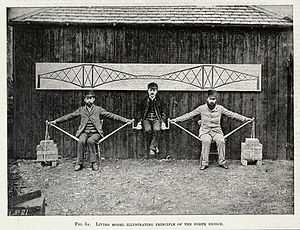Kaichi Watanabe

Kaichi Watanabe (渡邊嘉一 Watanabe Kaichi, 22 March 1858—4 December 1932) was a Japanese engineer who studied and worked in Scotland, United Kingdom during the 1880s. He was one of the first Japanese engineers who came to study in the UK. He is best known for his work with Sir John Fowler and Sir Benjamin Baker in cantilever bridge construction, notably on the Forth Bridge.
Watanabe studied under Henry Dyer, the Scottish engineer associated with technical education in Japan. After obtaining a degree from the Faculty of Technology of the University of Tokyo, he studied at the University of Glasgow from 1885 and graduated with a Civil Engineering and Bachelor of Science degree,[1] and worked as a construction foreman on the Forth Bridge, which crossed the Firth of Forth in eastern Scotland in 1890.[2]
Watanabe's image became well known in the 1887 photograph illustrating the cantilever principle, in which he poses with Fowler and Baker, suspended between the engineers who form a cantilever structure with their arms.[3]

In 2007, this photograph was incorporated into the design of the £20 banknotes issued by Bank of Scotland to commemorate Watanabe, Fowler and Baker's contributions to Scottish bridge engineering and their work on the Forth Bridge. The photograph appears in the upper right of the reverse of the note.
Conductor Takashi Asahina is the illegitimate son of Watanabe.[4]
References
- ↑ "University of Glasgow engineer to appear on new £20 note". University of Glasgow. 2007-10-02. Retrieved 2008-02-19.
- ↑ "Rail bridge builder on £20 notes". BBC News. 2007-10-08. Retrieved 2008-02-19.
- ↑ "Forth Railway Bridge". Forth Bridges Visitor Centre Trust. 2004. Retrieved 2008-02-19.
- ↑ 中丸美繪 オーケストラ、それは我なり(in Japanese) Bungeishunjū pp.35-49, 2008 ISBN 9784163705804